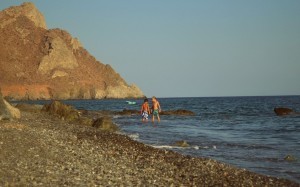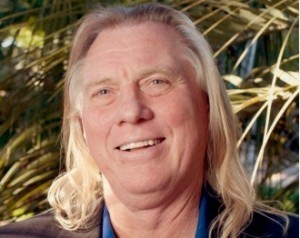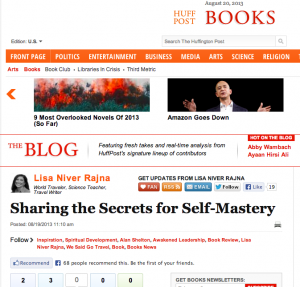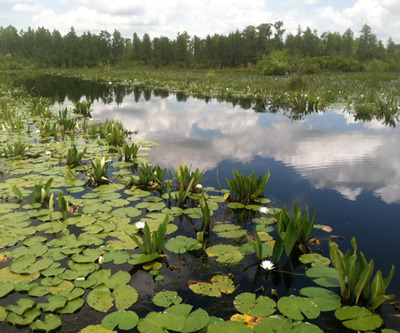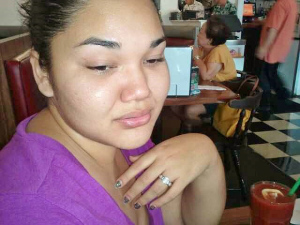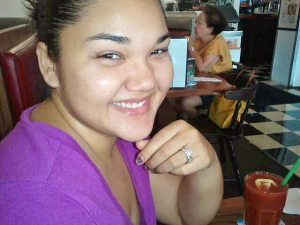Lisa Niver's Blog: We Said Go Travel, page 471
August 29, 2013
Aquincum – The Roman Ruins of Budapest
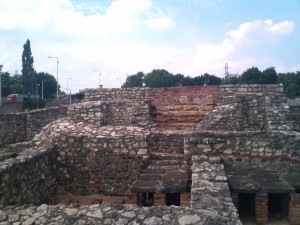 The capital of Hungary, Budapest, conjures images of a cruise on the Danube, wine tasting, spicy foods, Sziget Festival and thermal baths, sprinkled with historical places such as the Fishermen’s Bastion. But few travelers know that, not very far from the very well-known sites of Budapest, there is an interesting Roman gem, waiting to be discovered.
The capital of Hungary, Budapest, conjures images of a cruise on the Danube, wine tasting, spicy foods, Sziget Festival and thermal baths, sprinkled with historical places such as the Fishermen’s Bastion. But few travelers know that, not very far from the very well-known sites of Budapest, there is an interesting Roman gem, waiting to be discovered.
Yes, you’ve read correctly. Budapest is home to the ruins of ancient Aquincum , an important town in the Roman province of Pannonia. Before the Huns took over the region, the Romans have settled here between the 1st and the 5th century.
Personally I didn’t even know about this site until my trip to Budapest in July 2011. My husband, knowing my fascination for archeological sites, suggested we should plan a visit. And we did. In the middle of summer, in scorching heat, we had the site to ourselves.
For me, visiting Aquincum set the theme for our next travels. Within two years, we have visited Rome with its Roman Forum and Coliseum, Greece with its Roman Agora , Greek Agora and Acropolis, Romania with its Ulpia Traiana Sarmizegetusa… but it’s always the Aquincum which holds a special place in my heart.
A little bit of History
Emperor Vespasian established a military camp in Pannonia by the mid 1st century BCE which helped the city grow. The easy of crossing the Danube at that point and also the fertile planes helped the area to grow as well.
In 106, Emperor Trajan made Aquincum the capital of Lower Pannonia (Pannonia Inferior) and it only mean the area was about the develop further. In early 2nd century a Roman legion was stationed here and the city was classed as a municipium by Hadrian in 124. In 194, Septimus Severus classed it as colonia. Later, Emperor Diocletian made Aquincum the capital of Pannonia Valeria.
But the great migrations started to pose a threat and the citizens gradually withdrew from Aquincum. When the Huns arrives in the 5th century , they found it deserted.
The historical site
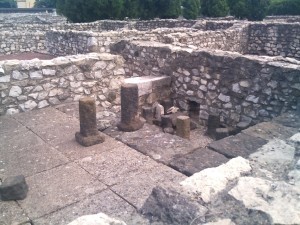 In the 19th century, the site was gradually excavated – work is still going on in present days. The remains are extensive and there is also a museum on site. The archeological park is not open between November 1 and April 14.
In the 19th century, the site was gradually excavated – work is still going on in present days. The remains are extensive and there is also a museum on site. The archeological park is not open between November 1 and April 14.
The site comprises the remains of an amphitheater, mosaic floors, tombstones and statues.
The best thing about Aquincum is that you can walk pretty much anywhere – of course, there are areas which are perilous and therefore close to the public – and there is enough throughout the site so that you know what you are looking at.
Best time to visit
I have made the mistake to visit the site right smack during a very hot summer day. Please don’t do the same. Plan for a morning stroll. Wear good walking shoes and don’t forget the bottled water. Since the archeological park is only open between mid-April and late October, chances are the weather will be hotter rather than colder.
How to get to
Aquincum is located in the oldest part of Buda (Obuda). Take the HEV from Batthyany ter (a stop on M2 line) all the way to Aquincum stop.
All photos by Krisztina P. and may not be used without permission.
The post Aquincum – The Roman Ruins of Budapest appeared first on We Said Go Travel.
Myanmar: Biking Inle Lake and Village Leg Rowers After School(video)
WATCH: 35 Biking Inle Lake and Village Leg Rowers After School, Myanmar (Burma)
Myanmar: Biking Inle Lake and Village Leg Rowers After School(video)
We Said Go Travel http://www.wesaidgotravel.com/ October 19, 2012 After the biking in Bagan, I was not sure about biking around Inle Lake. I thought, “Can I do it?” It was supposedly thirty minutes to the Lake but of course it was not. We passed a winery that we would visit later. Near a school, I almost fell down so I was so dizzy and felt sick. We never saw Inle Princess Resort Hotel but we did stop at Inle Resort Hotel. It is a large resort and we sat and enjoyed the lake. I especially enjoyed the black swans.
On the way to the village Mine Thauk we saw a few schools, an orphanage, and a monastery, we passed Red Mountain Vineyard but did not go this day. See our other biking video for views of the vineyard.
We had a noodle lunch at Wang Thouk Restaurant. The best part of the day was when we went to the jetty: we saw all the school kids picked up by LEG rowers!
We also saw festival boats for 45 and 104 people.
The ride back was not too bad. It was much cooler. George said: “You did not give up.” That was my nice thing he told me. I felt so sick at one point but I did keep going and it was a great day.
This movie is from our 28 days in Myanmar (Burma) from September 28, 2012 to October 26, 2012 and our year TRIP in South East Asia, see all the videos from our trip.
Our memoir, Traveling in Sin, is available at Amazon; it is a HOT NEW RELEASE!
Traveling in Sin is a HOT NEW Release on Amazon! from Lisa Niver Rajna
Traveling in Sin is a true tale of TRANSFORMATION thought LOVE and TRAVEL! After meeting online (on two different sites), George and Lisa travel internationally, give up their jobs, condo, ice cream and toilet paper in search of adventure and love. Along the way, Lisa sheds over 60 pounds and the couple gets engaged underwater in Thailand. There are tears, twists and true love!Recent Press:
By Amy Sommer on Westside Today By Dani Stone on Diets in Review
The post Myanmar: Biking Inle Lake and Village Leg Rowers After School(video) appeared first on We Said Go Travel.
August 28, 2013
Northern Seoul – “Rice wine, Monks, and Sheep”
Thank you to Chris Backe for sharing one of his Seoul Itineraries with us from his book, Weird and Wonderful Korea
“Welcome to Korea! An introduction: South Korea – home of soju, kimchi, and love motels. Presented here are the weird and wonderful parts of Korea – the places that tourists rarely reach and even locals don’t know much about. Read this for the real stories and histories behind some of Korea’s most unusual and fascinating destinations.”
Itinerary #1: Northern Seoul – “Rice wine, Monks, and Sheep”
Baedari Brewery – the museum of rice wine Stars: ***
Baedari Brewery has been brewing makgeolli (rice wine), jukyoju (a clearer and more potent rice wine) and soju (Korean fire-water) since 1915. In 1974, Goyang makgeolli was sent to Pyeongyang for the first inter-Korean summit. This museum, dedicated to the brewery’s history, was founded in 2004, and today the fifth generation continues the legacy. Although Baedari continues to produce alcohol, you won’t see it at every corner store. While this particular museum / brewery doesn’t offer taste tests or samples, plenty of offerings exist in the restaurant. Start by entering the main building and appreciating the first few simple exhibits – the majority of the collection is upstairs on the second floor.
A dim light seems appropriate for the dated items that once assisted in the manufacturing of fermented rice wine (known as
막걸리, or makgeolli) and soju. The technology these days is much better of course, but looking at over 90 years of history has its merits as well. They have the wear and tear expected of items used in an industrial setting on a daily basis. Some are simply displays, while other exhibits are models describing the different processes of making rice wine – unfortunately, nothing is in English for the foreign visitor or tourist. Try reading the descriptions if your Korean is good or a Korean friend is with you.
Once you’re finished with the museum, there’s Korean food
(including 김치전, kim-chi jeon, kimchi pancakes, 12,000 won) and locally-brewed makgeolli (3,000-6,000 won per
glass) downstairs. While the typical makgeolli is fine, give the 천년초 막거리 (cheon- nyeon-cho mak-keo-li, or cactus makgeolli) a try. It’s a little pinker and sweeter. There is some irony that you’ll only get by reading the bottle’s labels – Baedari’s cheap but ‘traditional’ makgeolli contains wheat from the US, as well as aspartame. The premium- labeled glass bottles, meanwhile, use organic rice.
Name: Baedari Brewery (배다리 박물관) Address: Gyeonggi-do, Goyang-si, Deokyang-gu, Seongsa-dong, 470-1
Korean address: 경기도 고양시 덕양구 성사 1 동 470-1 Directions: Use the Seoul subway system to get to Wondang station, line 3, exit 6. Cross the street and walk about 500 meters. Look to the right – the building is fairly easy to spot. Hours: 10am-6pm (weekdays) 10am-7pm (weekends) Admission: free (food and drinks are comparably priced to local restaurants) Phone: 031-967-8052 Website: http://www.baedari.co.kr
More from Chris on his site: weirdandwonderfulkorea.net
The post Northern Seoul – “Rice wine, Monks, and Sheep” appeared first on We Said Go Travel.
Greece: Walk On The Wild Side
As you’re going up the Asterousia mountains, it occurs to you. What if the car stalls and quits, then what? You check your watch for the umpteenth time. The road sign said thirty k., you’ve been driving for over forty minutes and no sea in sight. Just as you’re about to make a U-turn, you come across Miamou. The tiniest village dash oasis in the desertscape of the imposing mountain range. You wonder whether to take a break in the one and only coffee shop of the village or go on, in case you reach your destination at some future point. Either way, you win. The locals let you know it’s a short fifteen minute to where you’re heading and thus recharged, you forge on.
You go down and down and, suddenly, you see it. The Libyan Sea appears before you, timid and savage all at once. Though you’re only stealing glances at it through the mountain peaks, your intuition isn’t mistaken. You’re nearing a magical place.
Lendas means lion and looking up at the haughty rock formation shielding you from indiscrete looks, you understand where the name comes from.
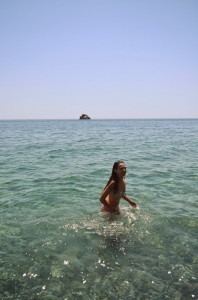 You get off the car at the village, stretch, drink all the water you went without during the ride and you start acquainting yourself with the place.. Some rooms to let, small taverns and bars which, though true to the image of a typical Greek island, in fact remind you of none of the places you have so far visited. Something different is happening here, you can tell through your skin. It probably is the natural energy of the place, it’s surely no accident this village has existed here for the past two thousand and four hundred years! Here was the Aesclepium where the souls of the ancient Greeks found peace. Here, you will too.
You get off the car at the village, stretch, drink all the water you went without during the ride and you start acquainting yourself with the place.. Some rooms to let, small taverns and bars which, though true to the image of a typical Greek island, in fact remind you of none of the places you have so far visited. Something different is happening here, you can tell through your skin. It probably is the natural energy of the place, it’s surely no accident this village has existed here for the past two thousand and four hundred years! Here was the Aesclepium where the souls of the ancient Greeks found peace. Here, you will too.
The crystal clear sea of Lendas makes no promises, all comparisons are beside the point. It invites you to come and see for yourself.
The finishing line is now very close. You get in the car (or, if you feel rested, you can walk the distance) to get to Dytiko or Disko as the locals call it, which is a kilometer and a half away. Tents, huts, hammocks and hippies of all ages welcome you warmly as if you were a life-long neighbour. Some in broken Greek, others in Cretan. With one look, you know you’re safe here. No one is going to steal from you, judge you, bother you. Naked sun-tanned men, wildly beautiful women and happy children playing with their dogs, in and out of the water.
You have reached as close as is possible to Paradise. You get rid of your clothes and dive in. The feeling that comes over you is not something the greatest writer or photographer or painter could give you. It’s called living and you only get it by doing it.
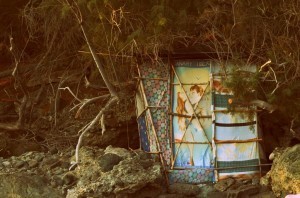 Late in the afternoon, with raki and its attendant morsels, you realize why the rock across the way is called ‘the Indian’. You clearly make out the nose, the eyes, the mouth and the braided hair..
Late in the afternoon, with raki and its attendant morsels, you realize why the rock across the way is called ‘the Indian’. You clearly make out the nose, the eyes, the mouth and the braided hair..
The Lion on one side and an Indian on the other. Small wonder why the hippies, those nature and life lovers, chose this place as their home. Nothing here is yours or mine. It’s all ours, it belongs to us, the curious travellers who seek out real peace and wild beauty and have come across both in Lendas.
About the Author: Dafni Mathioudaki is an aspiring writer from Greece. She studied in the Hellenic Cinema and Television School Stavrakos and over the years she took many creative writing courses. She also worked as a copywriter, find her on Facebook and Twitter.
The post Greece: Walk On The Wild Side appeared first on We Said Go Travel.
HuffPostBooks: Sharing the Secrets for Self-Mastery
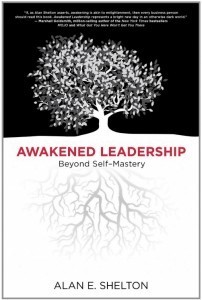 In his book, Awakened Leadership: Beyond Self-Mastery, Alan Shelton shares stories of his journey of transformation across decades and continents. His self-actualization to become an integrated awakened leader shines as an example of possibility to others. One of his gifts to leadership thinking is the new word: “intellectuality, the ability to be engaged in the shared intellect that permeates the heart. When practiced in the leadership context, it may be the largest paradigm shift in leadership thinking ever experienced.” Shelton is ready to reveal his gifts and assist you on your voyage.
In his book, Awakened Leadership: Beyond Self-Mastery, Alan Shelton shares stories of his journey of transformation across decades and continents. His self-actualization to become an integrated awakened leader shines as an example of possibility to others. One of his gifts to leadership thinking is the new word: “intellectuality, the ability to be engaged in the shared intellect that permeates the heart. When practiced in the leadership context, it may be the largest paradigm shift in leadership thinking ever experienced.” Shelton is ready to reveal his gifts and assist you on your voyage.
Many people look outside themselves to figure out how to change their lives, they search for “happiness” when they seek “joy, peace, love, money, pleasure, and fulfillment.” Shelton’s key secrets are: “You already are what you are seeking. The secret here is to start where you are. You are enough — let your power come to you.” As he says, “Relatively few of us have the insight that the transformation required is primarily an inside job.”
Whether you are a “spiritual seeker looking for truth” or a “corporate type looking for authenticity,” Shelton has something for you. His early life included a close connection cut short with an intellectual grandfather, an absent father and an abusive step-father with a belt with a large buckle that he used against Shelton and his younger brother.
Full incorporation of all parts of himself was an early challenge and Shelton segmented himself with his family or his friends at school. His lifelong search for integration is shown from his school days through his term as a Mormon Missionary in Peru in 1972. Always rising to leadership whether as zone leader to 140 missionaries in Southern Peru or shielding his younger brother, he was led to his own mentors including his grandfather, his professor, Stephen Covey, and Osho.
Osho’s accent and the occasional oddly placed word were no problem. It was as if my grandfather himself were speaking to me. I immediately knew that this man knew… Before I even finished hearing my first Osho discourse, I knew that I needed to go to India and ‘get experience.’
His connection with his grandfather and his search for more led him to India.
But experience in India is unsettling to all first timers, “Bicycles, taxis, motorcycles and scooters, motorized rickshaws, battered cars with mismatched colors and parts, and trucks of every size and description were jockeying for position on the road… Just about every vehicle I saw had more people stuffed into it or piled on top of it than you would think is humanly possible… Despite the obvious poverty and pain, I couldn’t help but see beauty everywhere.” Shelton perseveres and rises to the top at the Osho Pavilion as he did in Peru.
Although Osho and his methods have met with criticism, Shelton took what he liked and left the rest. He immediately found a way to receive a new name: “Anand Darpan,” meaning “blissful reflection.” Through his years in India and active seeking, he “had metamorphosed into a leader in organizational development with a strong foundation in the spiritual world.”
The last three chapters of his book share about “presence, service, and relationship… You will know which doorways to pass through if you let your intuition draw you to them.” Along your personal journey, you may find as Shelton did that: “Your thoughts and actions become creative responses to what is, rather than attempts to control it.” Rather than trying to do or force a situation, Shelton recommends surrendering to the idea that you are enough and breakthroughs will happen as you see more possibilities. “Awakened Leadership is the recognition that the only stable thread that weaves itself through your experience and that of the people you lead is the internal peace that you contribute to the fray. This sense of peace is not your possession.” Shelton states that the major problem for humans is believing we are in control of the “script in life.” Humans want to be the producer, director and writer without realizing that this is causing the problems and not the way to a solution.
Shelton’s book is an invitation and as he says, “Welcome to the mystery of your own journey. Are you ready to let life live you?”
His book is waiting to assist all who want to walk through the doorway:
My message to you is that your journey is authentic no matter where it takes place. If you’re a corporate animal, much like myself, then that is the arena in which your search unwinds. Everything you need to reach home is already within the world you inhabit, for Source is everywhere. And consciousness is all there is.
This article first appeared in Huffington Post Books.
More about Alan Shelton and Awakened Leadership: click here.
About the author of this review: Lisa Niver Rajna is a passionate writer, speaker and global citizen who has traveled to over one hundred countries and six continents. She and her husband, George, co-authors of Traveling in Sin, are spending a sabbatical year in Asia, follow their journey at We Said Go Travel.
The post HuffPostBooks: Sharing the Secrets for Self-Mastery appeared first on We Said Go Travel.
August 27, 2013
Why Female Solo Travel is Safe, and Awesome
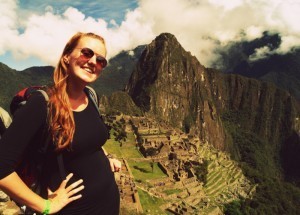 Female solo travelers are constantly being asked that age old question about how possible it really is for a woman to travel alone. I have been on both sides of that conversation, asking the question before I had ever really traveled, and responding to it now, after four years of being on the road, three of which were by myself.
Female solo travelers are constantly being asked that age old question about how possible it really is for a woman to travel alone. I have been on both sides of that conversation, asking the question before I had ever really traveled, and responding to it now, after four years of being on the road, three of which were by myself.
I don’t blame people for asking that question; if you’ve not traveled much or just been away on vacation-style breaks from a full time job once or twice a year, women traveling alone can be a very alien concept. Furthermore, if you’re used to always having a partner by your side, it can be a pretty daunting prospect, too. In truth, I’ve personally found that traveling alone as a woman has been the single most liberating experience of my life, and has helped me to grow and develop in ways I would never have imagined.
How I came to be a female solo traveler
My first traveling experience was interrailing around Europe for two months with a friend when I was 20 years old. This trip was what really kicked off my life of travel, and I finished that trip eager, desperate, and hungry for more.
One of the very first people I met on that trip was an Australian woman who was traveling alone. I had never met a woman who had done such a thing, and over the course of the next few weeks and months when we bumped into each other I picked her brains about solo travel. She seemed like a completely free spirit to me – her plans were constantly changing depending on what she felt like doing or the people she met. The world and everything in it was hers. I wanted to be that girl. I was determined to be that girl.
I came back from that trip and planned my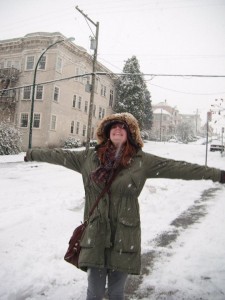 next great adventure; traveling to Canada alone. I figured it was an easy destination to start with as I shared the same language and felt like it wouldn’t be much of a culture shock. My first week in Canada alone was a bit shakey, and I continually doubted myself and my strength to be able to do this. I remember taking my first step out onto Granville Street in Vancouver, jet lagged to oblivion, and thinking to myself, ‘I’ve just flown 6,000 miles away from anyone I know on this planet. What on earth have I done?’
next great adventure; traveling to Canada alone. I figured it was an easy destination to start with as I shared the same language and felt like it wouldn’t be much of a culture shock. My first week in Canada alone was a bit shakey, and I continually doubted myself and my strength to be able to do this. I remember taking my first step out onto Granville Street in Vancouver, jet lagged to oblivion, and thinking to myself, ‘I’ve just flown 6,000 miles away from anyone I know on this planet. What on earth have I done?’
Having said that, it didn’t take me long to make plenty of new friends in my hostel, and once I got used to the whole idea I couldn’t get enough of traveling alone. The freedom was like nothing I’d ever experienced, and I really feel like solo travel has made me the person I am today.
Since then, I’ve lived in both Barcelona and Toronto, and traveled through the Balkans and South America, all of which have been solo adventures. I have been incredibly lucky to have stayed safe throughout all of these journeys, but at the same time I’ve kept my head screwed on, and remembered that’s my gut instinct is my most powerful weapon.
Some difficulties you might face traveling as a woman alone
I’ve always said that there is only really one difference between travel safety advice for men and for women. The normal safety tips apply for all – don’t go down sketchy-looking streets alone, make sure you keep an eye on your personal items at all times, and just keep your wits about you.
As a woman traveling alone, the one thing that might happen is you get unwanted advances from men, such as whistling, cat calling, hissing, etc. This all depends on the country you’re in; I had some unwanted attention from men in South America (I’m a redhead with pale skin – I stand out quite a bit there!) but for the most part it was harmless and I walked by with an air of confidence, ignoring them completely, an attitude which I have found to be te best defence.
Having experienced solo travel for so long, I can say that the rewards far outweigh the dangers. The best thing you can pack for a female solo trip abroad is a good sense of judgement. Know that you should, to a certain extent, have 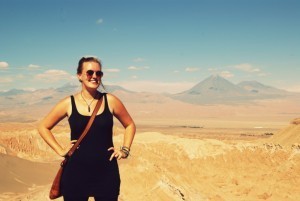 your guard up and not trust people immediately, but still travel with an open heart. Always remember that just because a place is far away, or has a very different culture to your own, doesn’t necessarily make it dangerous. Inform yourself with factual information about a country from government websites, not what you read in the newspapers.
your guard up and not trust people immediately, but still travel with an open heart. Always remember that just because a place is far away, or has a very different culture to your own, doesn’t necessarily make it dangerous. Inform yourself with factual information about a country from government websites, not what you read in the newspapers.
Finally, know that the leap into traveling alone as a women will probably be one of the best leaps you ever take – I never knew how strong I could be until I took to the open road, just me and my backpack.
About the author: Emma Higgins has been writing/travelling on and off since 2009. Her blog, Gotta Keep Movin’, is full of stories and advice from her trips, which include Europe, India, Morocco, South America, USA and Canada. Her focuses are budget travel and volunteering, and she’s been involved in sustainable farming in Argentina, animal shelters in Peru, and making goat cheese in British Columbia. Follow her on Facebook, Twitter & Instagram.
The post Why Female Solo Travel is Safe, and Awesome appeared first on We Said Go Travel.
From Flight Attendant to Travel Writer
 An interview with author, Tiffany Hawk
An interview with author, Tiffany HawkHow did you go from flight attendant to travel writer?
I’ve spent most of my life trying to travel for free or even get paid to travel. After college, some of my friends did the whole backpacking through Europe thing, but I didn’t have anything resembling a savings account let alone a trust fund, so I became a flight attendant. I got to live abroad, travel to almost every state and to dozens of countries, and I had an unlimited stash of free write-your-own tickets that would get me anywhere I wanted on my days off. It was unbelievable to have that kind of freedom.
Then after 9/11, I got laid off. I was based in London and my work visa was voided, so in a pretty ironic twist, they sent my broke, unemployed ass back to the U.S. – in first class. I desperately didn’t want to leave London or my flat or my friends or my job, so I sat in that first class sleeper suite crying into my Dom Perignon and gourmet cheese plate.
Seriously, though. I was 24 and thought I would die if I had to go back to a gray cubicle. So I spent the entire 10-hour flight working through the What Color is Your Parachute career guide. And I had a brilliant idea. “I know…I’m going to be a travel writer!”
I was so naïve. I didn’t know anything about the media and publishing industries, but I read everything I could and talked to everyone I could and spent every last penny of disposable income on classes. And now I’ve written for the publications I dreamed of, worked as a magazine travel editor, and have a book out.
How did your novel come about?
Honestly, I think I just couldn’t let go of the past. I wrote a lot of short stories and essays about my time at United, partly to process my grief about 9/11, and partly to relive the glory days. But then as those pieces accumulated and gradually started morphing into a novel, I was on a mission to bring the world an authentic, emotional look at the flight attendant life, something more than the caricatures we usually see – the perky bimbo, the battleaxe, the catty gay man. I wanted to really explore what it means to live everywhere and nowhere.
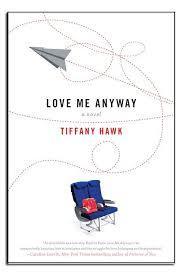 Love Me Anyway doesn’t stick to the glamorous side of travel. Was that deliberate?
Love Me Anyway doesn’t stick to the glamorous side of travel. Was that deliberate?
I was completely committed to showing a deeper side of the airline world – funny, serious, good, bad, ugly, sexy, lonely. That said, if I had written this book before 9/11, it probably would have been more glamorous, not just because the industry has changed so much, but because I have. Being a flight attendant really does mean living in this incredible world where anything seems possible, and every day brings something new. But as anyone who travels a lot knows, it’s not always like being on vacation. The thing is, though, the most extraordinary, most life-changing moments usually happen when we’re pushed past our comfort zones.
In the opening pages of your book, you say flight attendants are running away from something. How true is that?
Most of the time, when you get hired as a flight attendant you have to be wiling to relocate to any base the company chooses. It definitely takes a unique kind of person to be able up and leave everything you know. From what I saw, within a few months of starting work, people usually ended up quitting the job or walking away from whatever ties they had. Some people straddled two worlds, but shortly after my class graduated, we had divorces (including mine, lovely story) and girls who quit the moment their boyfriends proposed.
Do you have any other stories from your flight attendant life that didn’t make it in the book?
So many stories just didn’t fit. I would have loved to have included one of my more touching flights. It was Thanksgiving 2000, and a series of long delays and repeated cancellations had put my Albuquerque-bound passengers through the ringer. They had spent hours on the tarmac only to be sent back to the gate, more than once. They’d missed the holiday, and they were pissed, enraged even. It was the kind of fiasco that can turn into death threats and fist fights, truly. But at some point, these people just let go of the anger, decided to make the best of it and bonded with each other and with the crew. To this day it warms my heart that as I was saying “buy-bye,” I was invited to several belated family dinners. Unfortunately, I had to fly on.
Do you have any advice for budding travel writers?
This is not revolutionary, but it’s so often overlooked – study the publications you want to write for as if you were studying for the bar exam. When I was a magazine editor, I can’t tell you how many pitches I got that were wildly off-base. Also, don’t limit yourself to travel magazines or “travel” topics. You can just as easily get a travel story in a food magazine or a food story in a travel magazine. (Hint: Get creative and replace food with fitness or spa or fashion or science.) Almost any topic can be turned into a trip. So go hit the road and tell us about it!
More about Tiffany Hawk: Tiffany Hawk is a former flight attendant and the author of Love Me Anyway, a darkly funny novel about life at 35,000 feet. She has an MFA in creative writing from UC Riverside and her work can be seen in such places as The New York Times, The Los Angeles Times, National Geographic Traveler, and NPR’s “All Things Considered.”
Lisa’s review of Love Me Anyway on Huffington Post.
Want more to read about travel? Lisa and George’s memoir, Traveling in Sin, is on Amazon.com.

Travel Writing Road Tiffany Hawk
You could be writing from an exotic destination as a travel writer.
Get started with @tiffanyhawk’s online course: Click here to view more details
The post From Flight Attendant to Travel Writer appeared first on We Said Go Travel.
Travel Spot: The Fairmont San Francisco
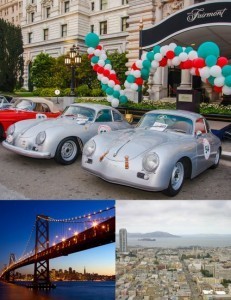 For your trip to “the Golden Gate city”, embark on a world-class travel destination by staying or visiting The Fairmont San Francisco. People often say it is a “hotel so grand they built a city around it”, and that they did. Resembling a European palace it proudly resides at the corner of California and Mason street, situated in the epicenter of famous cable car lines, and minutes away from the Financial District, Union Square, China Town, Fisherman’s Wharf and Ghirardelli Square.
For your trip to “the Golden Gate city”, embark on a world-class travel destination by staying or visiting The Fairmont San Francisco. People often say it is a “hotel so grand they built a city around it”, and that they did. Resembling a European palace it proudly resides at the corner of California and Mason street, situated in the epicenter of famous cable car lines, and minutes away from the Financial District, Union Square, China Town, Fisherman’s Wharf and Ghirardelli Square.Since 1907, The Fairmont has stood as a piece of history that stands atop Nob Hill overlooking rich culture and breathtaking scenery.For the Fairmont’s beauty and “terra cotta façade” has withstood The Great Earthquake and watched international dignitaries, heads of state and celebrities grace its walls.
Today the hotel stands proudly as a legendary tourist destination and a global host to thousands of people each year. The rich history of both San Francisco and the Fairmont San Francisco go back as far as the California Gold Rush of 1849 when James Graham Fair, a miner who made his fortune from silver, staked his claim in the summit of Nob Hill. Flash forward today, it’s captured Hollywood’s eye in Aaron Spelling’s Television series “Hotel” who commemorated the famous hotel lobby. The popular destination houses 591 guest rooms, 62 luxurious suites and 55,000 square feet of meeting and banquet space, thus it is no wonder this structure of vintage and modern luxury is known as the “west coast White House.”
Committed to protecting the environment the Fairmont hotel installed four honeybee hives atop their 1,000 square foot rooftop garden. Along with the already local and organic cuisine the sweet concoction can be found in the hotel’s afternoon tea service or on draft fittingly titled the Honey Saison served in the Laurel Court Restaurant and bar.
The Heart of Luxury
One can enjoy the lap of luxury in the hotels world famous Penthouse suite. Newly restored by Champalimaud Design from its original creation by American archeologist and art historian, Arthur Upham Pope, the suite itself is valued at $20 million dollars. The charming interior is reminiscent of the Roaring Twenties, and depicts a time period of America’s wealth and opulence. The suite spans 6,000 square feet across the entire eighth floor of the historic Man Building within the Fairmont. The Penthouse is home to icons such as President John F. Kennedy, Prince Charles of Wales, Tony Bennett & Mick Jagger, to name a few. With a price tag of $15,000 a night, the living quarters include three large bedrooms, a living room featuring a grand piano, a formal dining room, a professional-grade kitchen, a two-story circular library, a billiard room (covered in handcrafted Persian tile from floor to vaulted ceiling) and an open terrace with extensive views of San Francisco. Furthermore, amenities include dedicated personal “at your service”- should you desire a butler, housekeeper, a chef, massage therapist or personal trainer. The gourmet kitchen comes stocked with Ferry Building Farmer’s Market’s selection of fine wines, and organic produce. From Bvlgari bath products to personalized robes and 1,000 percent cotton or silk linen, fresh flowers and more. The Penthouse is the ideal destination for the ultimate extraordinaire and a must see on your visit to San Francisco.
About the Author: Amy Apodaca is a content specialist and style editor for HealthBeautyLife.com, a national publication that celebrates lives well-lived and admirable lifestyles through celebrity, health, beauty & fashion, food and travel.
The post Travel Spot: The Fairmont San Francisco appeared first on We Said Go Travel.
August 26, 2013
Okefenokee Swamp: A wetland of intrigue
The Okefenokee Swamp is one of Mother Nature’s mysterious places. Straddling the Georgia–Florida border in the United States, this 438,000-acre wetland offers intriguing landscapes, abundant wildlife and a glimpse into the past.
Land of the Trembling Earth
According to the Okefenokee National Wildlife Refuge Visitor Center, the swamp bottom “is sand, covered with peat. Methane gas deep in the peat propels large clumps of peat to “blow up” (rise or float) to the surface. Over time, these peat masses sprout plants and attract wildlife. They look like islands – but they’re not solid, and they’re not anchored to the swamp bottom. If a person or a large animal (like a bear) walks on peat blow-up, the ground trembles and the trees shake. Native Americans called these places ‘O-ki-fin-o-ke,’ Land of the Trembling Earth.”
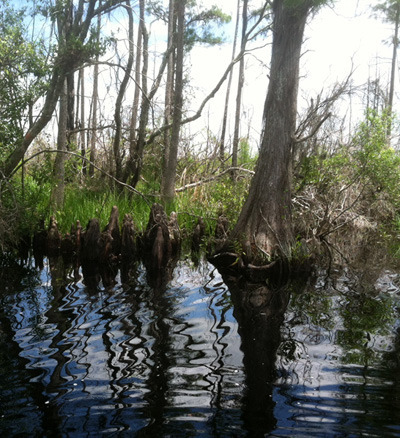 Boating on tannin-dark water
Boating on tannin-dark waterIt is easy to explore the Okefenokee Swamp because it is crisscrossed by more than 120 miles of water trails. Bring your own canoe, kayak or motor boat, or sign up for one of Okefenokee Adventures’ guided boat tours.
Their 90-minute tours on 24-foot Carolina Skiffs travel along the historic Suwannee Canal, which is lined with cypress, pine and bay trees.
The tour includes a visit to the Chesser Prairie, an open wetland area covered with water lilies and other water plants.
One of the first things you might notice about the swamp water is that is dark, tea colored due to the tannic acid released from decaying plants. The water crisply reflects the sky and surrounding landscape.
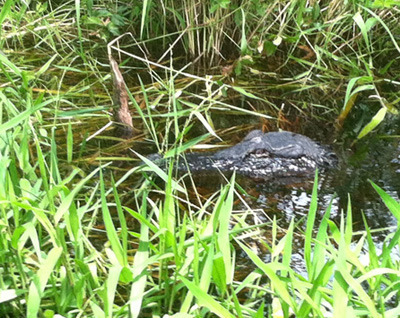 Wildlife galore
Wildlife galoreOne of the great things about exploring the swamp with professional guides is that they are able to point out and identify wildlife. They can also identify plants and answer questions about the region’s cultural and natural history.
Odds are high that you will see American alligators, egrets and herons. Depending on factors such as the season, time of day and water levels, you also may see otters, wood storks, deer, raccoons, bobcats and bears, and birds such as ibis, sandhill cranes and red-shouldered hawks, American alligators.
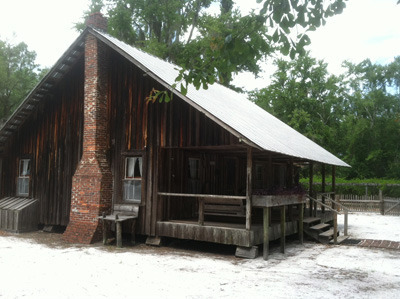 Chesser Island Homestead
Chesser Island HomesteadWhile you are in the Okefenokee National Wildlife Refuge, make sure to visit the Chesser Island Homestead, built by Tom Chesser and his wife Iva in 1927. As their family grew to include seven children, they lived off the land — growing, catching and shooting what they needed. They also produced sugar cane, tobacco and turpentine to sell.
Just as the Chesser family kept it, the yard is still kept as a barren yard of sand to reduce fire hazards and to make it easier to see snakes.
About the author
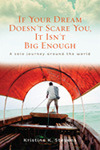 Kristine K. Stevens is the author of If Your Dream Doesn’t Scare You, It Isn’t Big Enough: A Solo Journey Around the World
Kristine K. Stevens is the author of If Your Dream Doesn’t Scare You, It Isn’t Big Enough: A Solo Journey Around the World . This nonfiction book tells the story of what happened when she sold her house, quit her job and traveled solo around the world.
. This nonfiction book tells the story of what happened when she sold her house, quit her job and traveled solo around the world.
The post Okefenokee Swamp: A wetland of intrigue appeared first on We Said Go Travel.
Lost Ring in Oahu!

Lost Ring in Oahu!
The day just started off on a bad note. My father in law let the dogs out in the front yard by accident…again. Leina, my fiancé, dragged herself out of bed early to watch the dogs. Sasha, our oldest dog, was not the problem. It was Pa’a, the one year old puppy, who was trouble. He had a history of chasing anything he could hump.
By the time I woke up to greet my future wife, she looked like a crab surrounded by a tornado of hormones and moodiness. There was only one way to reclaim the day at this point. “We’re going out for breakfast,” I said.
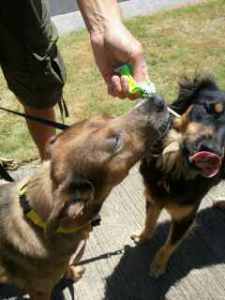 We took the high energy dogs with us, being sure to give them a long walk before going to the diner. Then we planned to go hike to the Lighthouse at Makapu’u. But we only made it ¾ around the block before she turned around and gasped. Her look of panic hit me like a flash flood. It only took half a second for me to read her mind. I sprung into action, retracing our steps as she muttered the dreaded words, “My ring!”
We took the high energy dogs with us, being sure to give them a long walk before going to the diner. Then we planned to go hike to the Lighthouse at Makapu’u. But we only made it ¾ around the block before she turned around and gasped. Her look of panic hit me like a flash flood. It only took half a second for me to read her mind. I sprung into action, retracing our steps as she muttered the dreaded words, “My ring!”
It was gone. Leina walked like a stunned zombie, bare finger in tow. Before I turned the corner, I said, “I have a feeling that it’s back at the house, but I’m going to circle back just in case”. My heart pounded as I knew we only had a matter of minutes before someone else could pick up the ring.
Thoughts pounded in my head. “What do we do if it’s not at home? Does this mean I need to buy her a new ring? I can’t afford a new ring. My poor baby…I hope she’s OK.” Through the high speed flow of mental notes, an image of the chestnut dresser next to our bed floated into my mind. A wave of calm came over me as the feeling in my gut told me that the ring is by that dresser. But there was only one way to find out for sure.
Thoughts pounded in her head. “How did this happen? What is he going to think of me? Is he mad at me? The thought of going to work without my ring makes me feel ashamed. Where is it?!” I felt her fear all the way around the block.
By the time we reconnected, I had already sprinted around the block with Pa’a. No luck. I ushered the family back to the car. “We’re going home to look for the ring,” I said with urgency. Once Leina hit the passenger seat, the tears poured down her face. “I’m so sorry!” she sobbed.
“Don’t apologize. I think I know where it is.”
Believe it or not, this is not the first time I have recovered a wedding ring. My mom lost her ring once in our garden. The acrobatic ring jack knifed into the 3 inches of fresh soil she had just laid down. I have the distinct memory of my deceased great grandmother over my shoulder, guiding my hand to the pin point location of the ring’s burial ground. My mom smiled at the news that Great Grandma Kennedy was watching over us. The presence of my deceased Grandma Kennedy continues to be a comfort to me, something that many people experience in our Bloodline Healing workshop, where I put my intuition to work to help others feel their ancestors. Great Grandma helped us recover my mom’s ring. I look forward to seeing how ancestors help the participants at our next workshop at Brandeis-Bardin (near LA, California) on October 10th-13th of this year.
But, Leina never took off her ring. Her rude awakening this morning made her frazzled, so she lost track of the ring on her finger. Damn her low-carb diet! Her fingers had obviously shrunk, making the ring easy to lose.
I barged through the door to our apartment, and stood in front of the chestnut dresser. I tossed the top drawers like scrambled eggs. Nothing. Had I lost my mojo? Despite the calming vision, another surge of anxiety surfaced when the ring didn’t immediately turn up. The zombie arrived in the room, fussing with the little corners where she stored jewelry. Nothing.
“I keep seeing this corner of the room, babe.” She helped me toss the pile of laundry at the foot of the dresser. Our comforter had oozed off our bed during the night to attack the laundry pile, making it a huge lump of cloth. 3 layers later, Leina’s hand retrieved the hiding engagement ring. She held the ring in a waterfall of tears. The shock, the pent up drama, and her gratitude poured through her eyes. I held her, feeling relieved that my intuition had helped me in another heart wrenching situation. It turns out that sleeping with a psychic has its benefits. “I’m so glad that you have ninja skills, babe,” she said. “You were so confident that we would find it here. I’m so lucky to have you.”
Leina looked at me with relief. “You know, there must be a lesson in all this,” she said. “Yea. Life is telling us to do the laundry,” I replied.
For more information about the Upcoming Bloodline Healing Workshop at Brandeis-Bardin on Oct. 10th-13th, please go to gkhunter.com
The post Lost Ring in Oahu! appeared first on We Said Go Travel.
We Said Go Travel
We Said Go Travel is a global community of over sixteen hundred writers with articles from every continent.
Stories are shared with photos and video from a perspective of the transformative power of travel. We Said Go Travel has hosted live and online events as well as travel writing contests around the world. ...more
- Lisa Niver's profile
- 57 followers



